Our Low FODMAP Kasha Varnishkes are not quite like the classic as that recipe requires quite a lot of thinly sliced, caramelized onion. We have done our best and used the traditional buckwheat groats, schmaltz (chicken fat) and (low FODMAP gluten-free) bow tie pasta and combined these ingredients with loads of scallion greens, leek greens and some of the white leek bulb. More on that below.
This dish is dedicated to Julie Cantor-Weinberg. She is part of our low FODMAP community and through our FODMAP IT!™ column, she requested this dish for a makeover. Julie, we hope our Low FODMAP Kasha Varnishkes tantalizes your tastebuds and keeps your IBS at bay.
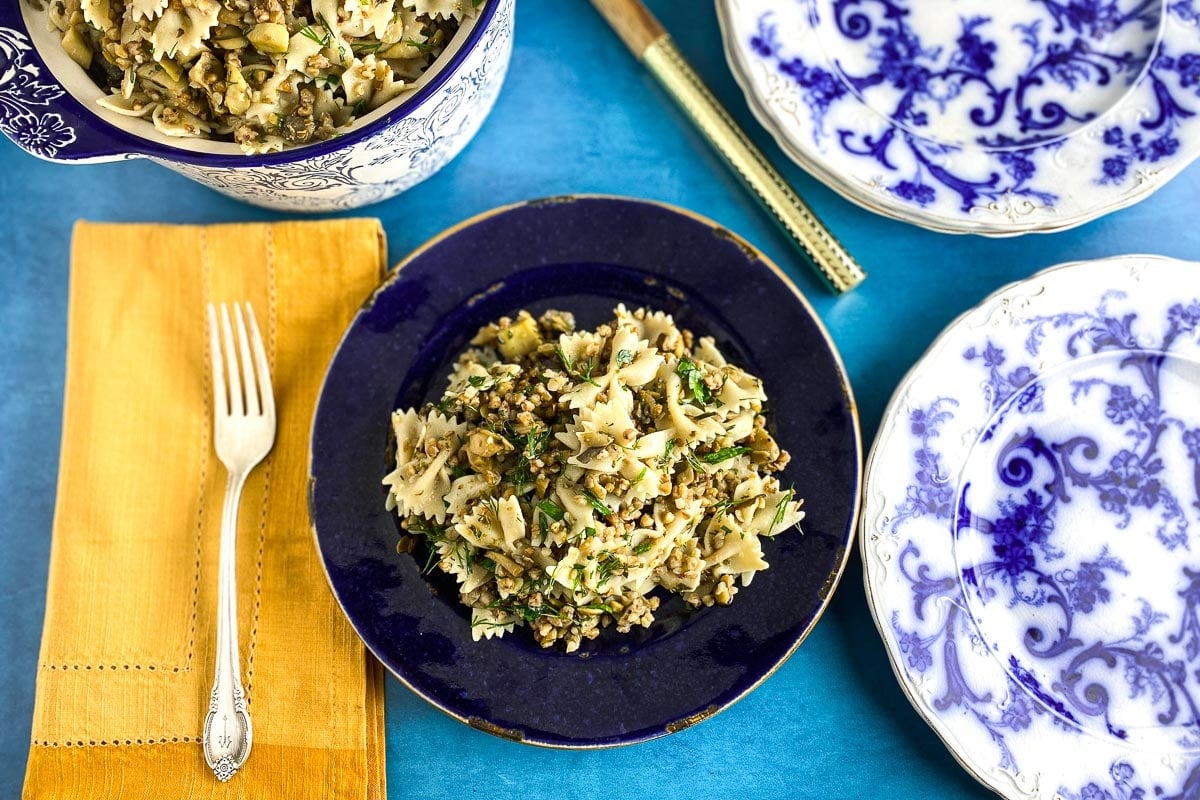
Ingredients For Kasha Varnishkes
In addition to the buckwheat groats, bowtie pasta, fat (usually chicken fat) and some sort of oniony component, there are other ingredients that you might find in one Kasha Varnishkes recipe or another.
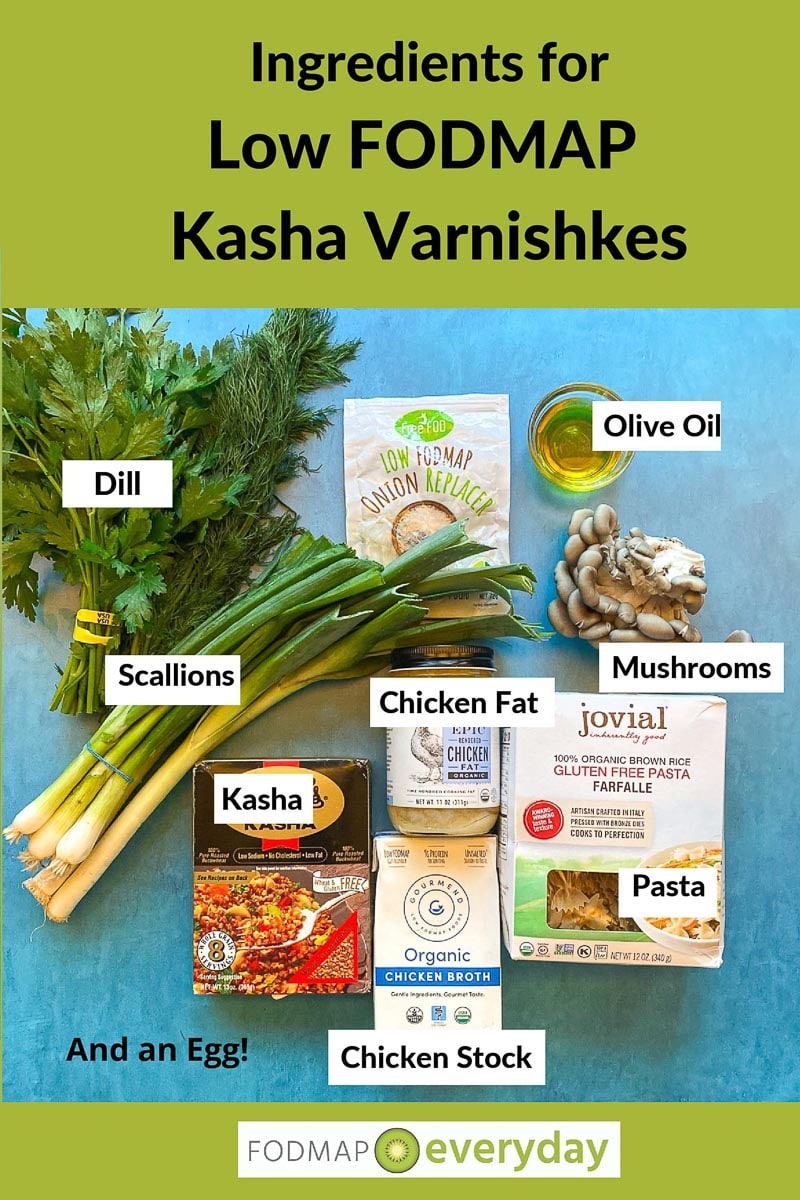
I like a generous shower of fresh chopped dill and flat leaf parsley, but you might even find cilantro in some recipes. Salt and pepper are definitely needed to balance out the dish, which is true for most cooking, but this dish seems to particularly require attention to seasoning, and you can do that to taste.
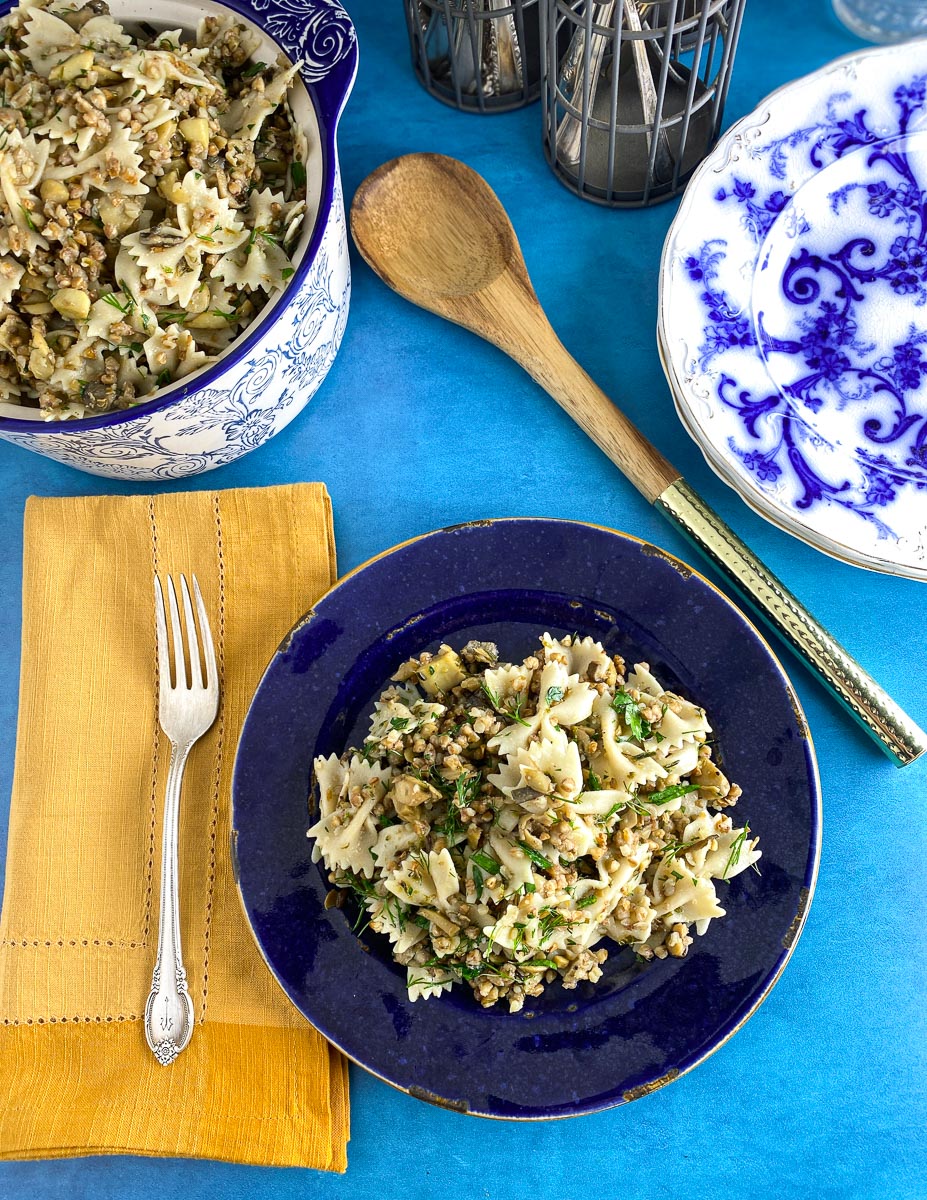
Mushrooms are not always used, but I have included a fair amount of oyster mushrooms, which have a generous low FODMAP serving size. I like including mushrooms because they add bulk and texture that are missing because we are not using voluminous amounts of sliced onion. In addition, they add umami, which really enhances this dish.
Sometimes chicken stock or beef stock might make an appearance and texture of the final dish can also vary. Sometimes all the ingredients are fairly tender and sometimes the dish is pan fried so that you develop some crispy bits (do this with leftovers!).
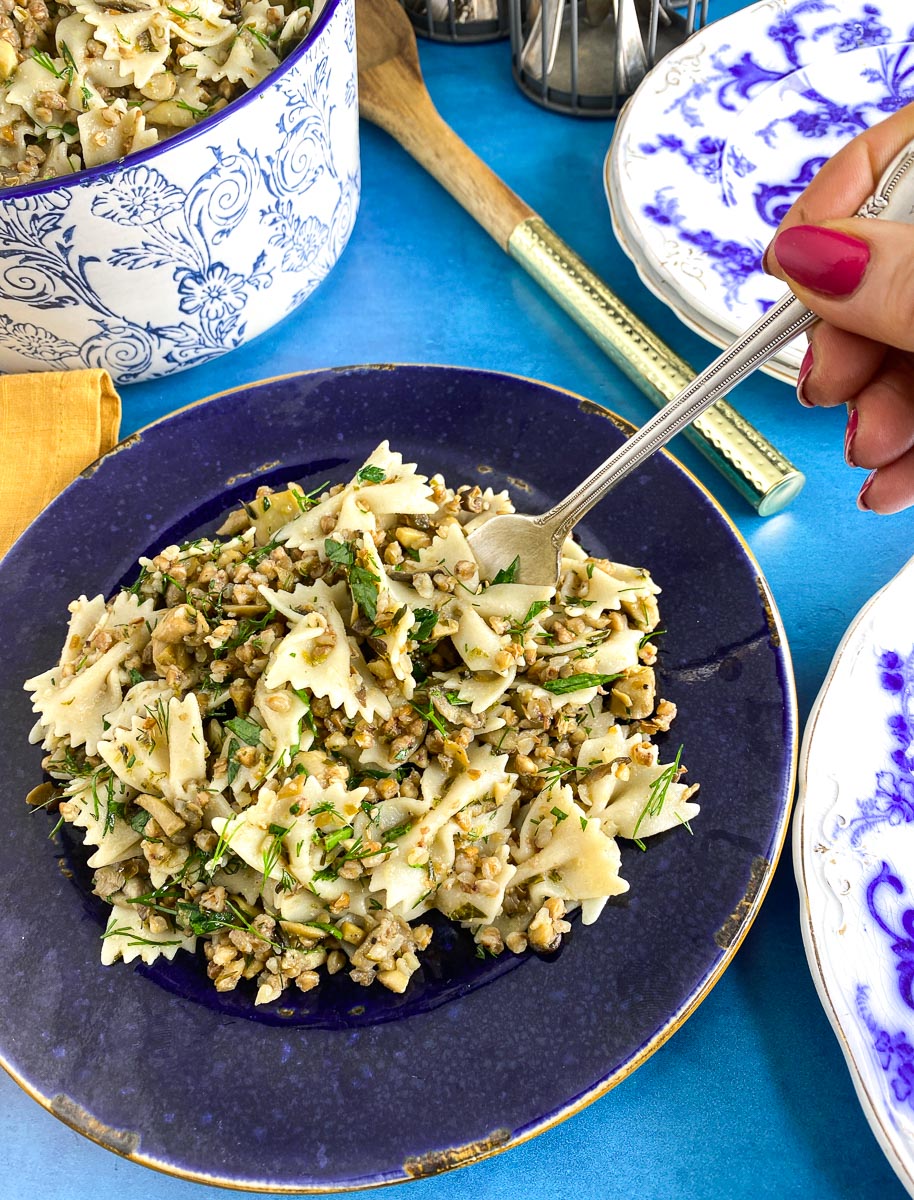
Frequently Asked Questions
Kasha Varnishkes, sometimes spelled as kasha varnishkas, is a hearty dish combining buckwheat groats and pasta, usually bowtie in shape, that is a traditional dish of American-Jewish Ashkenazi provenance.
A typical recipe for Kasha Varnishkes of this size will call for two or three whole onions, sliced thinly. If you have passed your onion Fructan Challenge, then be our guest. But for the rest of us we have to figure out how to substitute for that large amount of onions.
Most of you probably know that scallion greens and leek greens are low FODMAP in generous portions and we’re certainly going to take advantage of that. But did you also know that a portion of the white leek bulb is also low FODMAP?
Take a moment and go type “leek” into the Monash app. You do have the app, don’t you? You will see that there is an entry for leeks with the bulb and leaves combined. Monash University has lab tested them and states that a low FODMAP portion of bulb and leaves combined is ½ cup or 38 g. This amount is suitable for the Elimination Phase.
The problem with this app entry is that it does not tell us what ratio of bulb to leaves was tested. And, also, we know that the bulb itself is considered high FODMAP.
Based on this information I used a small amount of leek bulb in this recipe but was quite conservative in my approach (you will see the leek greens and bulb listed separately). This means there could be some amount of fructans in the dish that is indeterminant. As always, it is up to you to eat your tolerance and if you know that you are particularly sensitive to fructans then perhaps stick with just the leek greens.
To further bolster the onion flavor, I do ask that you use a seasoning product called FreeFod Onion Replacer. This is a granulated product with a pronounced onion flavor, which has also been lab tested and certified as low FODMAP by FODMAP Friendly. You will most likely have to mail order it, so plan ahead.
Okay, here’s the deal. Oyster mushrooms are tasty and meaty and also provide bulk for all the missing sautéed onions. They also have been lab tested by Monash University and have a low FODMAP serving size of 1 cup, chopped, or 75 g. That is a lot! The issue is that they might be hard to find, and they are not inexpensive.
Here is my suggestion if you’re taking an economical approach. Monash University has also lab tested conventional canned mushrooms and if you drain them, you can also use up to 75 g of those per low FODMAP serving. The caveat is that I do not think they have the best texture and they do not have much flavor, so I would not use them for the entire amount of oyster mushrooms called for. Use some oyster mushrooms and make up the difference with the drained canned mushrooms, if you would like to be more economical.
Kasha varnishkes will often be offered at Hanukkah, Purim, Rosh Hashanah, Sukkot as well as for Shabbat meals. It works fantastically well alongside roast chicken or brisket. Some families use it like a dressing (stuffing). It is really delicious any time!
Kasha Varnishkes is not hard to make. You have to boil water and cook the buckwheat groats and the noodles, and otherwise there is some sautéing. The two things to pay attention to are texture and seasoning. You don’t want to over-cook the buckwheat groats or the pasta, and you do want to make sure to season the dish with salt and pepper liberally, otherwise it can be quite bland. Also, calling for chicken fat might sound unusual, but it adds loads of flavor as well as texture.
Just as an aside, my stove conked out as I began working on this dish and I ended up using the burner on my outdoor grill. It all worked just fine, so I would say this dish is pretty easy, even running in and out to the deck.
Being without a stove was not optimum, but I kept up a running commentary via text with Marie M., one of our super-users from our Facebook Groups as I was cooking and it was like she was there on my deck helping!
You do not have to use chicken fat, although I think the results are vastly superior if you do. You can also use butter or a non-dairy equivalent if you like, but the result will be vastly different. BTW the chicken fat might be liquid or might be solid, depending on its temperature. I use Epic Provisions brand. (PS: If you are cooking palo, keto or Whole30 and use a lot of this, Cornhusker Kitchen brand is a less expensive way to go; this is just a PSA. Remember, neither Monash nor we recommend overlaying any additional restrictive diets along with low FODMAP).
Consider yourself lucky if you have leftovers! Add your fat of choice to a skillet – in this case I like using cast-iron. Pan fry the Kasha Varnishkes until warmed through and browned and crispy here and there. Top with a fried egg with a runny yolk and you will have a breakfast, brunch or lunch that is unparalleled – even dinner.
You can make low FODMAP chicken stock yourself, or there are many purchased options. I happen to love Gourmend Chicken Broth. Every batch of homemade comes out a little differently and certainly commercially prepared stocks vary from one another in terms of flavor and salt content. Gourmend is very flavorful yest mild, making it quite versatile.
Due to this fact you might have to play around with the amounts of salt and pepper. I find that this is one dish that really requires you to taste and adjust seasoning to your liking. If you have Smoke ‘n Sanity Essence of Onion, you could try that as well (it contains salt). The fact is that the pasta and the groats are very bland, so they need some help.
How To Make Kasha Varnishkes
Fill a large pot with generously salted water and bring to a boil over high heat. Cook the noodles till al dente and drain, then add back to the pot.
Make sure your scallions and leeks are very finely chopped, like this:
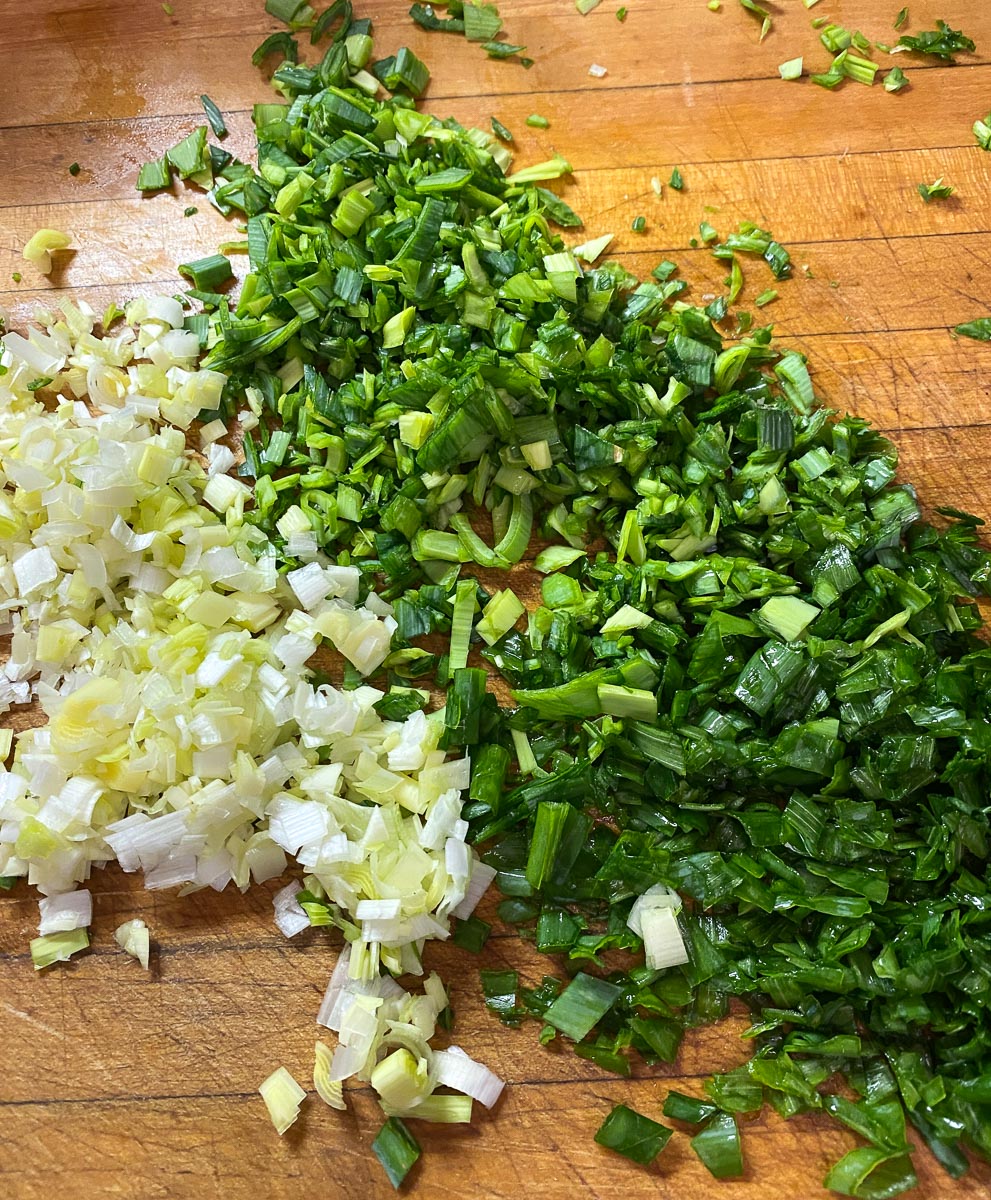
Meanwhile, in a large wide saucepan or skillet over low-medium heat, melt and heat the ½ cup (120 ml) of schmaltz and olive oil. Add the leek greens, scallion greens and leek bulb to the pan.
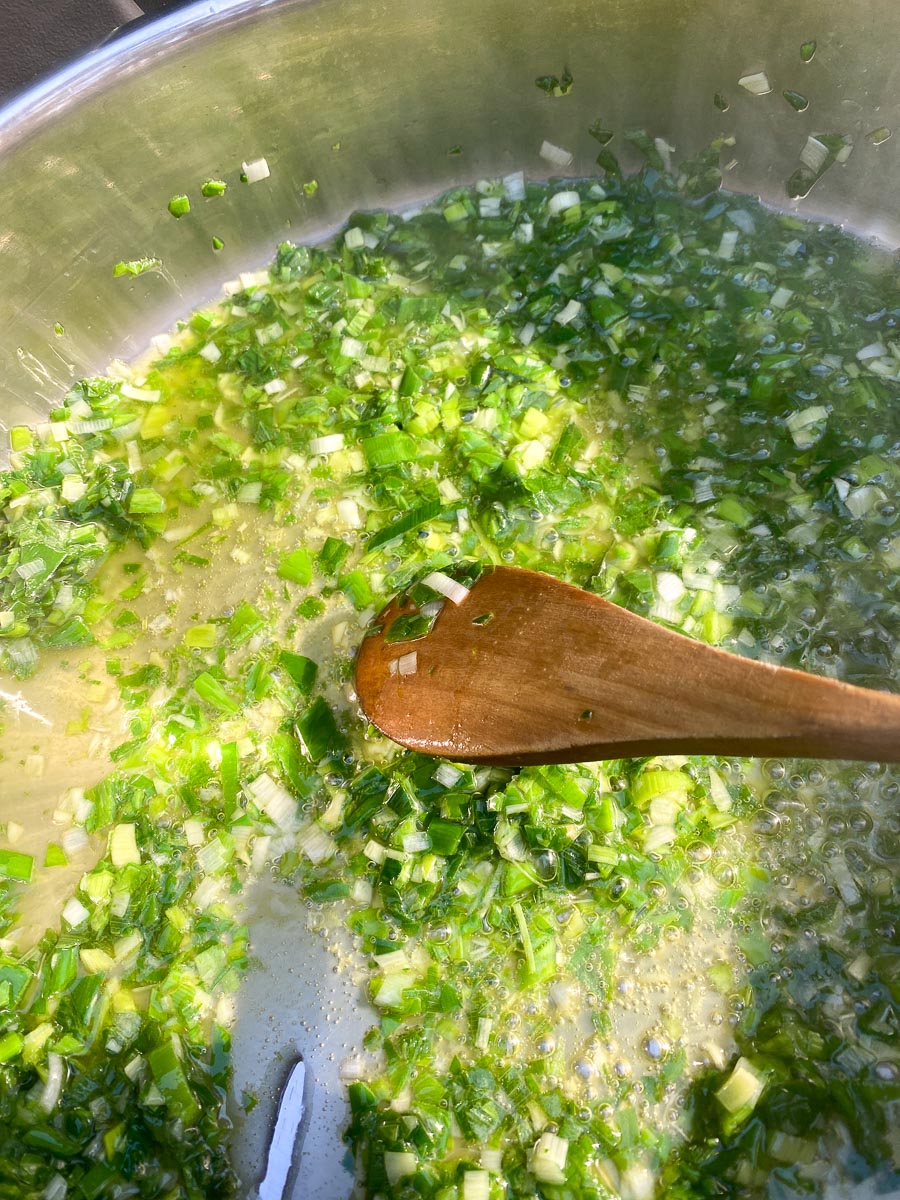
Cook, stirring often, until golden, about 20 to 25 minutes; don’t rush this step.
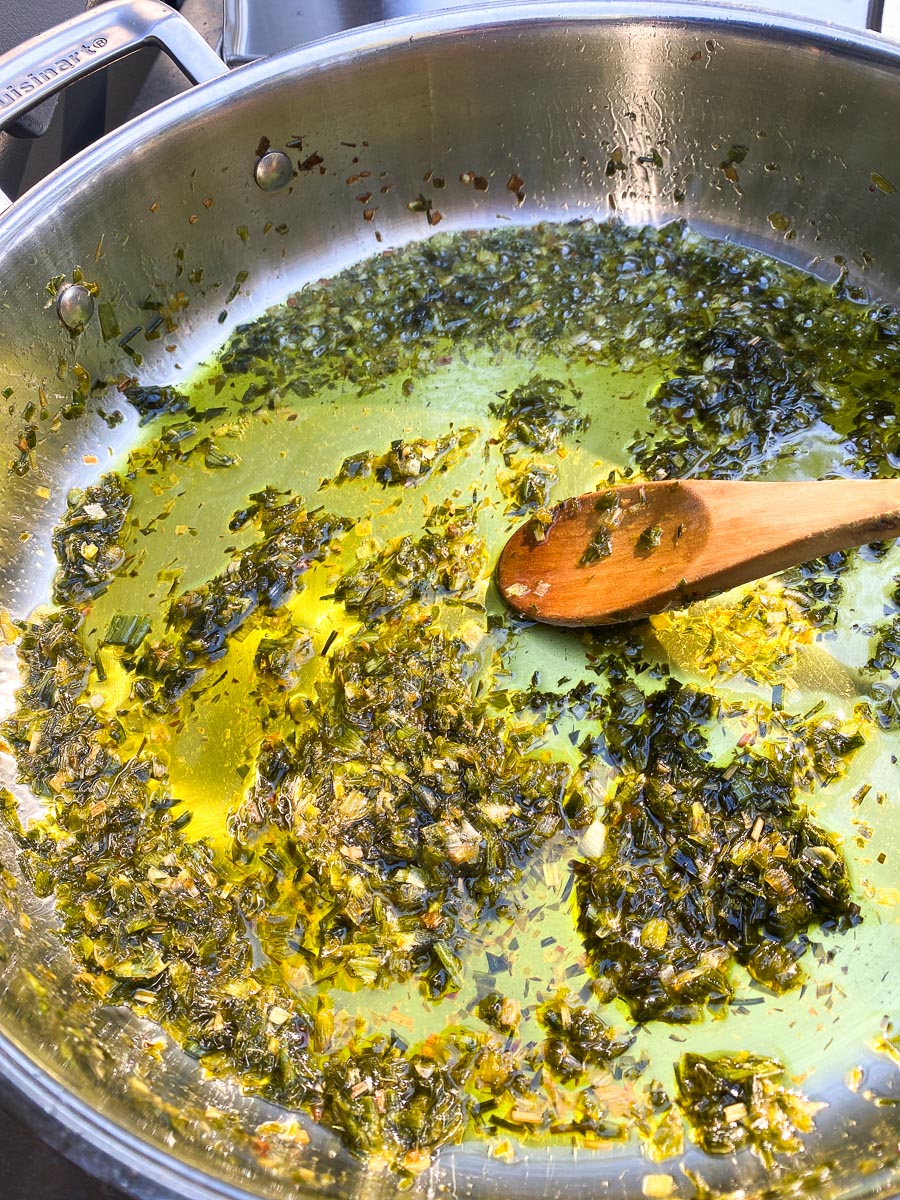
Add the mushrooms, season with salt and pepper.
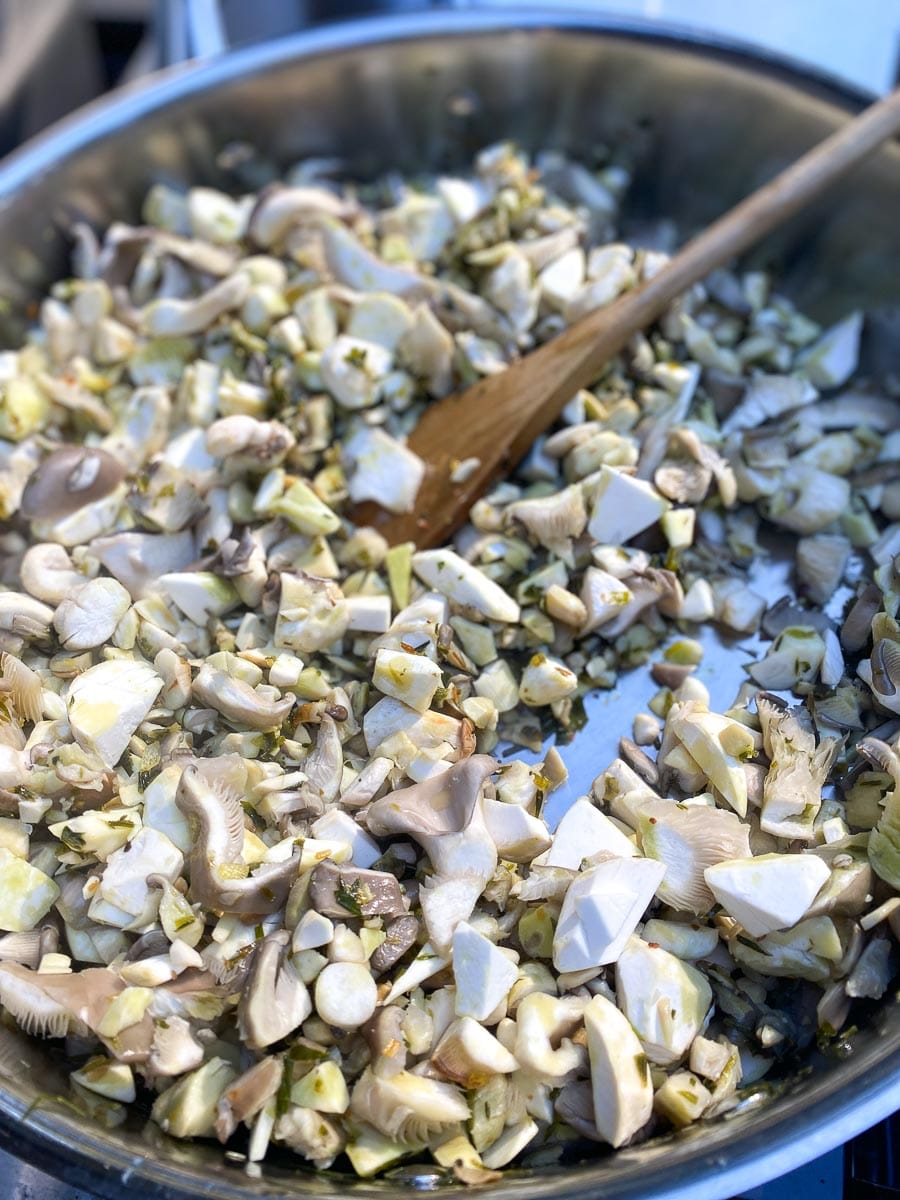
Cook, stirring often, until the mushrooms give off most of their liquid and the leeks and scallions have darkened further, about 10 minutes more.
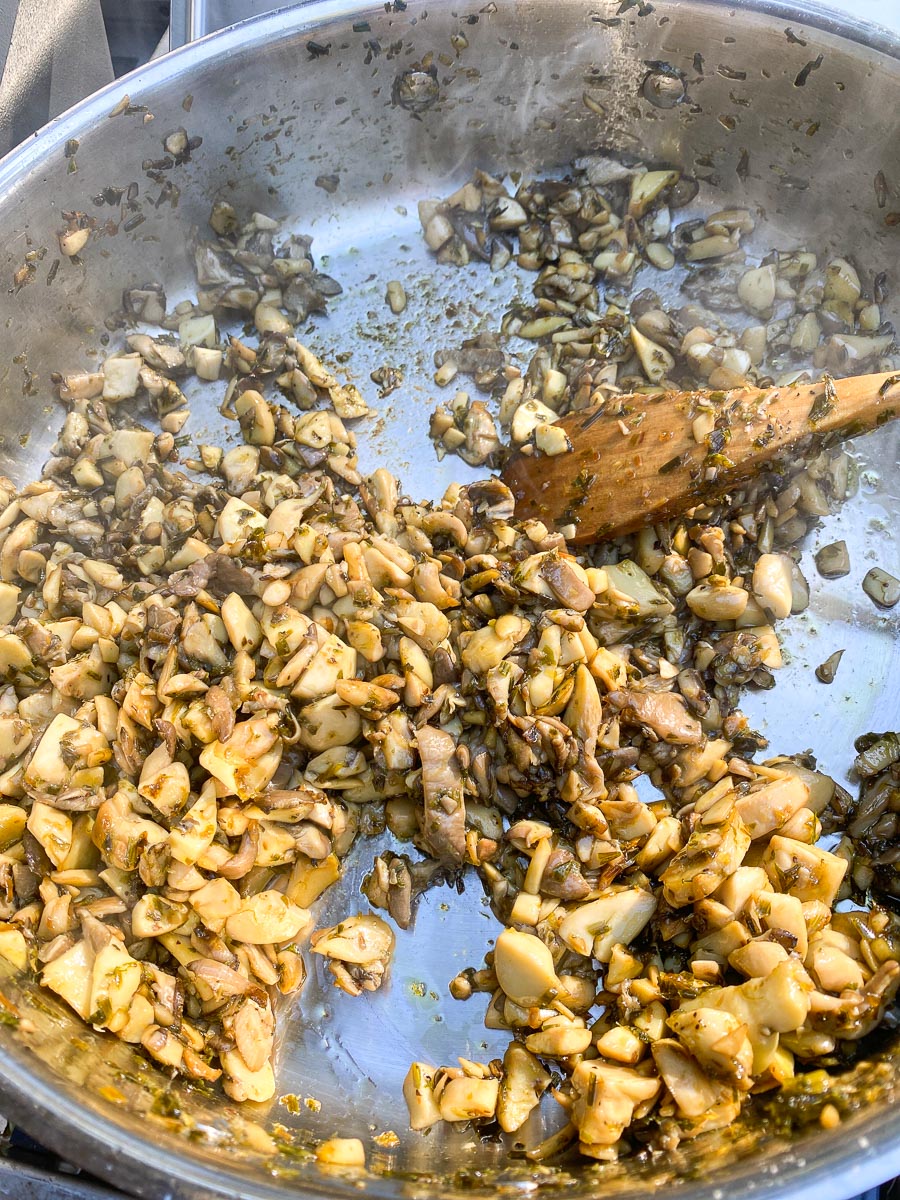
The mushrooms will retain some bouncy texture. Taste, and season with additional salt and/or pepper, as needed. Transfer the mushroom mixture to the pot with the pasta. Wipe out the pan and set aside for later.
Beat the egg in a small mixing bowl, then stir in the dry, raw groats, making sure all the grains are evenly coated.
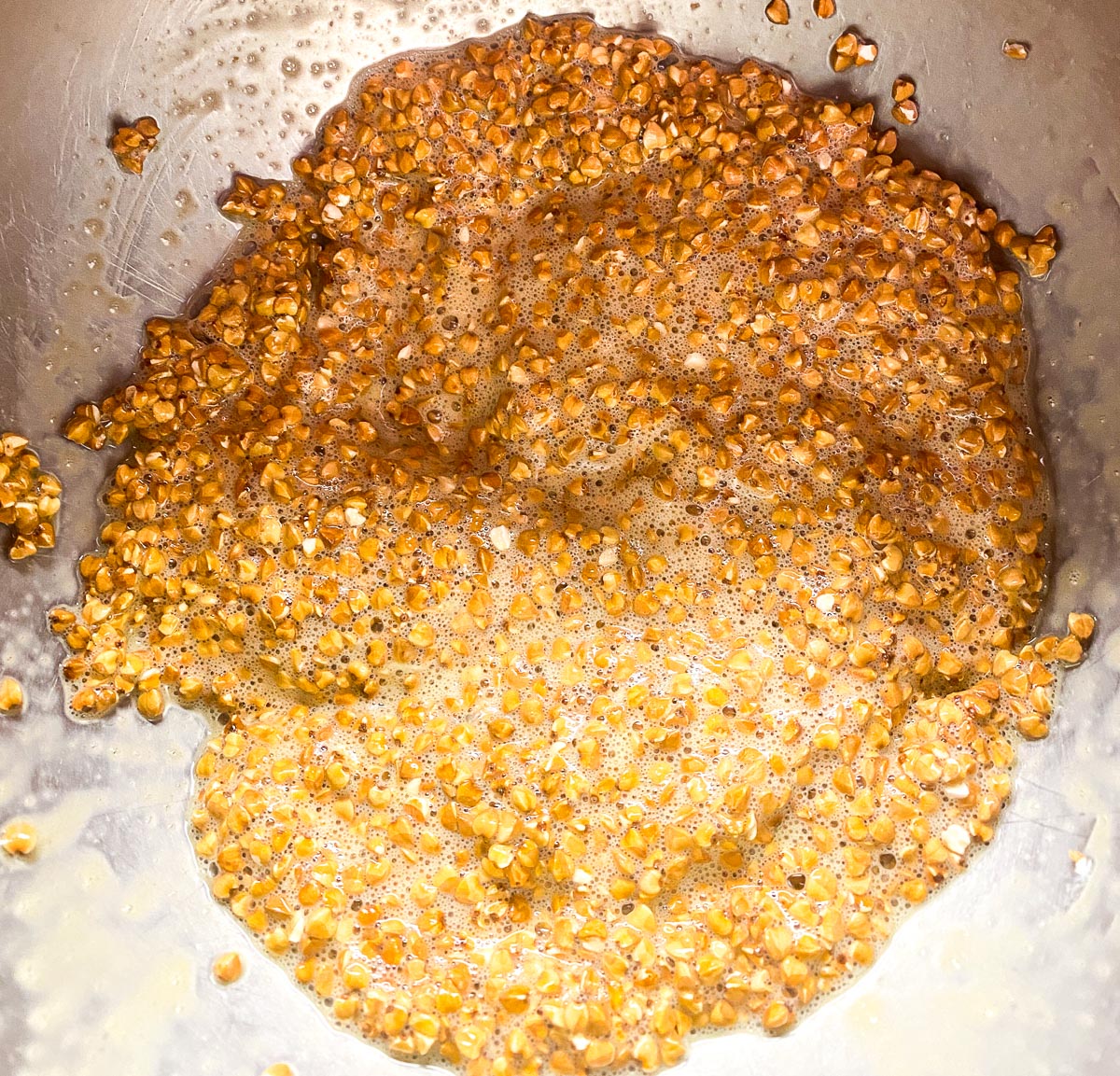
Scrape the kasha into the reserved pan and set over medium heat. Spread the kasha out into an even layer and stir for a few minutes or until the egg has dried on the kasha grains, the kernels take on some color, begin to emit a toasted fragrance, and are mostly separate.
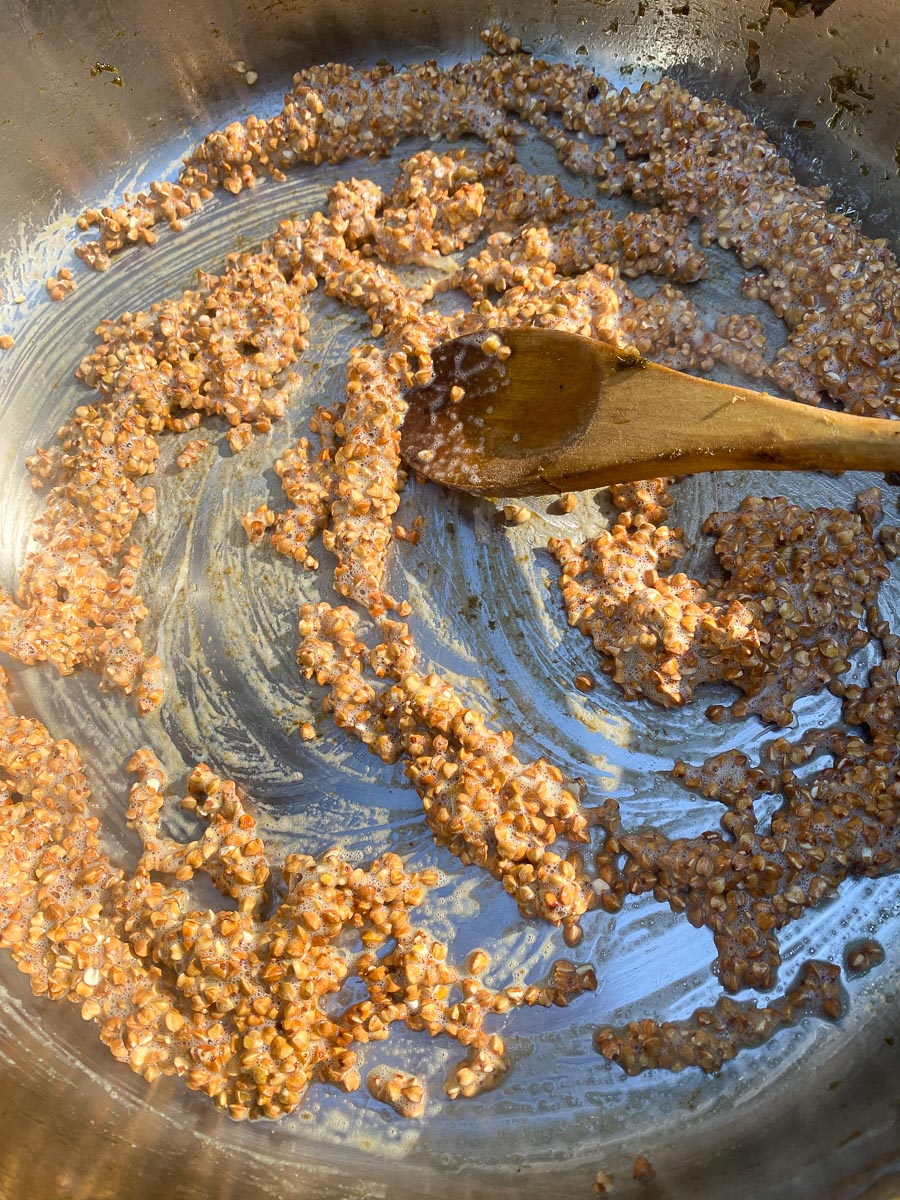
Stir in the chicken stock.
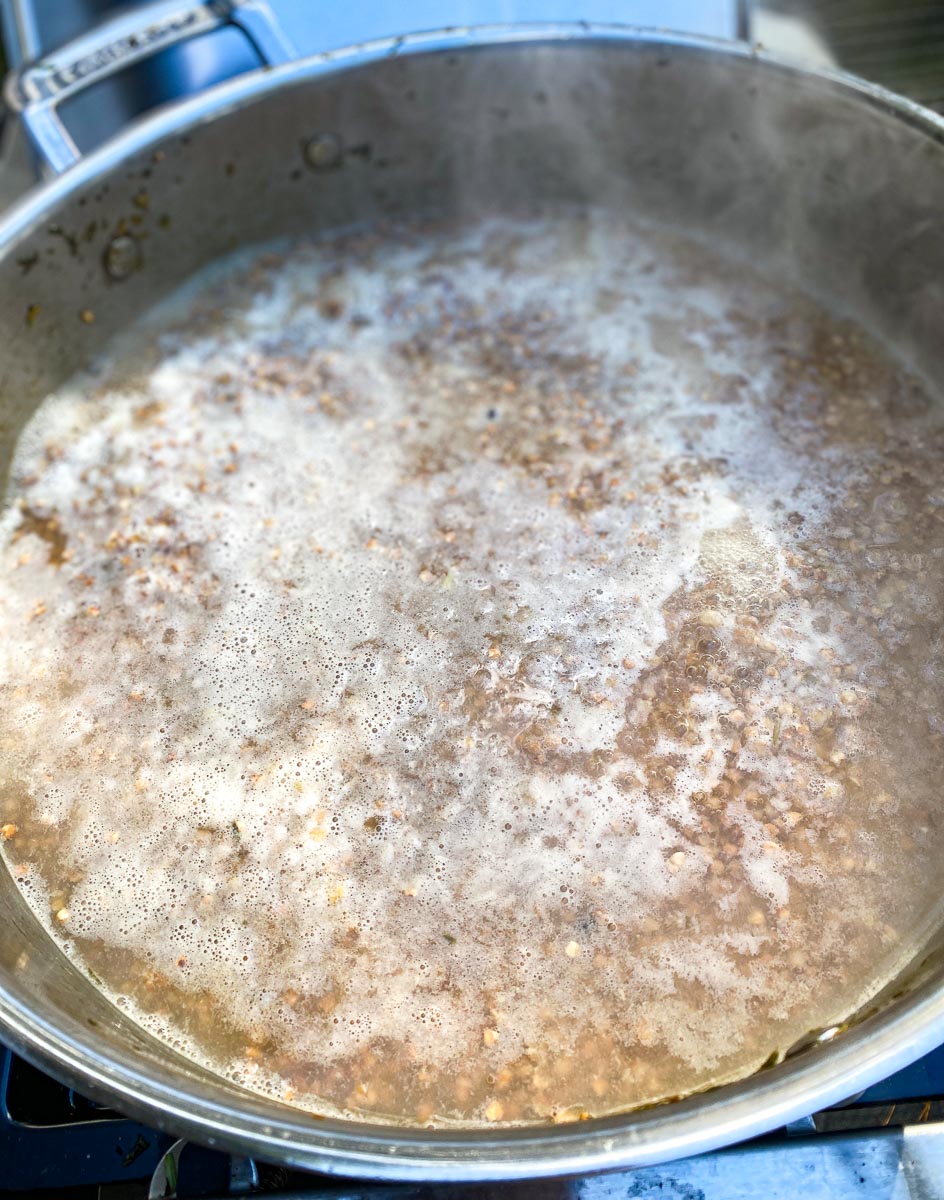
Cover, bring to a boil, then adjust heat to low and cook until stock is absorbed, and groats are tender, about 10 minutes (give or take). Fluff the grains with a fork and re-cover the pot to team for a few minutes.
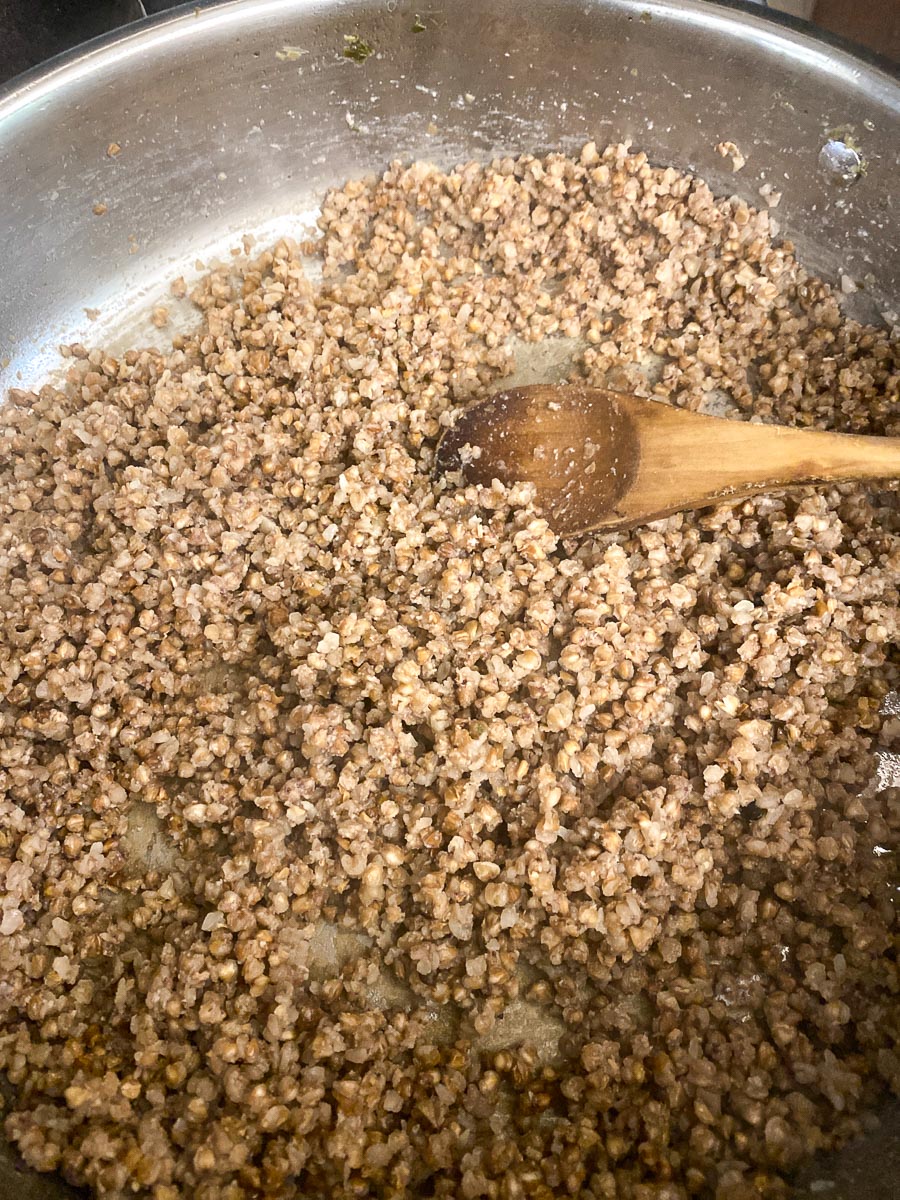
Add the cooked buckwheat to the pasta along with the dill and parsley, reserved 2 tablespoons schmaltz and FreeFod Onion Replacer to the pasta pot.
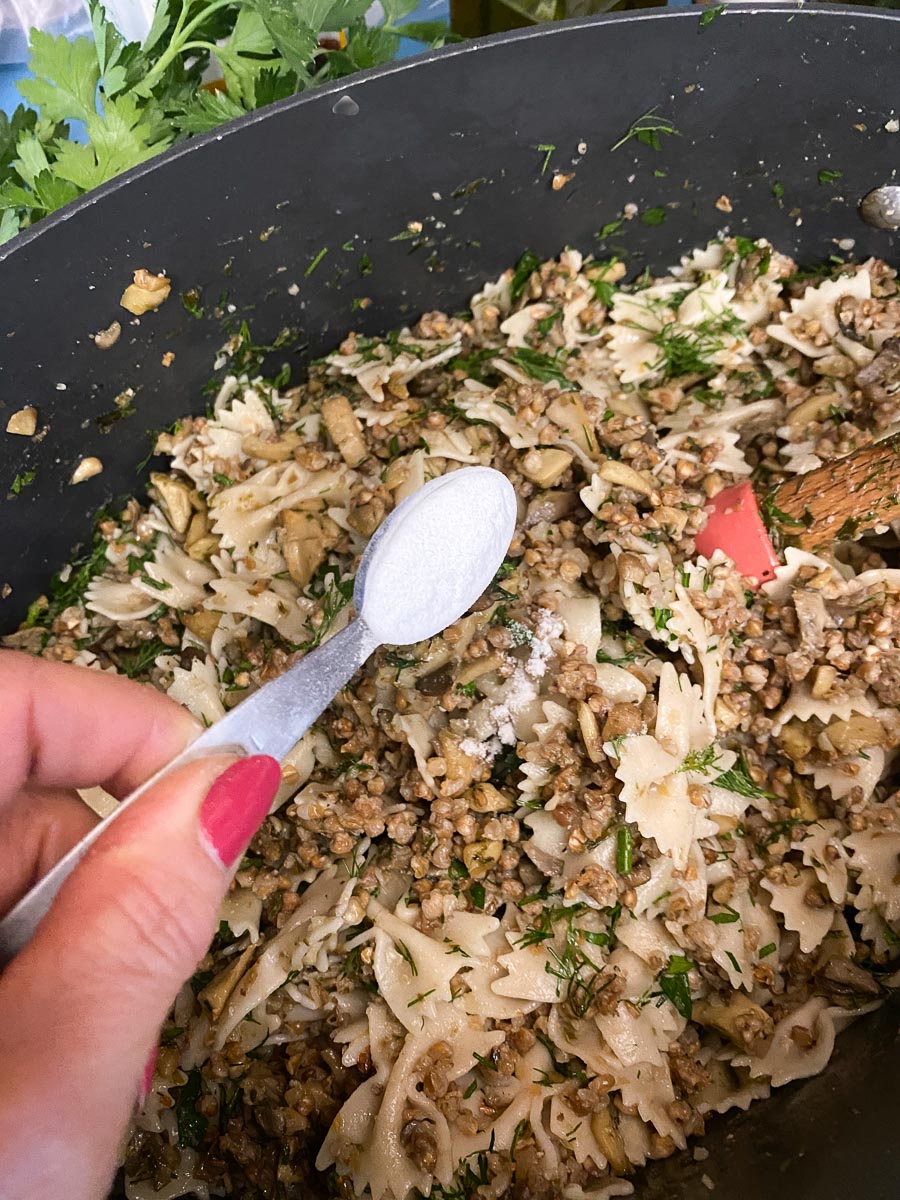
Fold until everything is combined and heat gently over low heat, if needed. Taste, adjust seasoning and serve. Leftover kasha varnishkes can be refrigerated in an airtight container for up to 4 days. We like to reheat in a pan with more schmaltz until some of the noodles are a bit crispy. A shower of fresh herbs is nice, too, right before serving.
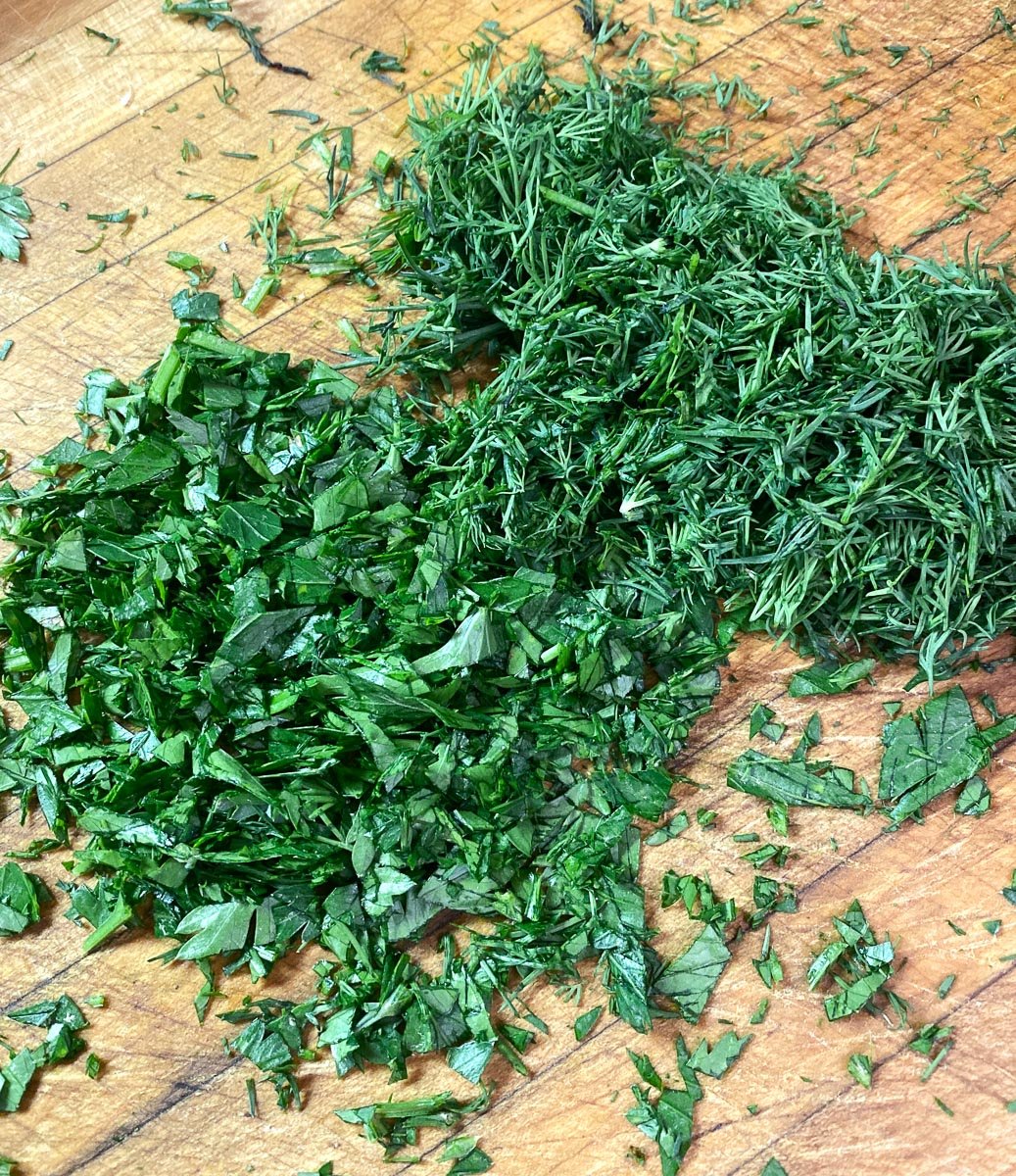
FODMAP Information
Our recipes are based on Monash University and FODMAP Friendly science.
- Eggs: Eggs are high in protein and do not contain carbohydrates, according to Monash University.
- Leeks: The green parts of leeks are low FODMAP as determined by Monash University lab testing and can be used to add onion flavor to your low FODMAP cooking. Monash also states that a combination of leek bulb and leek greens are low FODMAP in ½ cup (38 g) portions, but we do not know the ratio of bulb to greens.
- Pasta: You have to read labels, but there are many low FODMAP gluten-free brands of pasta available. Use what is called for in individual recipes. Our go-to is rice-based pasta. Monash University and FODMAP Friendly have both tested “gluten-free” pasta, but they do not specify what the pasta was made from. Monash says gluten-free pasta is low FODMAP at 145 g or 1 cup cooked; FODMAP Friendly lab testing suggested 2 cups or 146 g cooked is low FODMAP. Monash has also lab tested pasta made from rice, which they list under “rice stick” and it is low FODMAP at 220 g, which no Moderate or High FODMAP amounts given.
- Scallions: The green parts of scallions are low FODMAP as determined by Monash University lab testing and can be used to add onion flavor to your low FODMAP cooking.
Please always refer to the Monash University & FODMAP Friendly smartphone apps for the most up-to-date lab tested information. As always, your tolerance is what counts; please eat accordingly. The ultimate goal of the low FODMAP diet is to eat as broadly as possible, without triggering symptoms, for the healthiest microbiome.
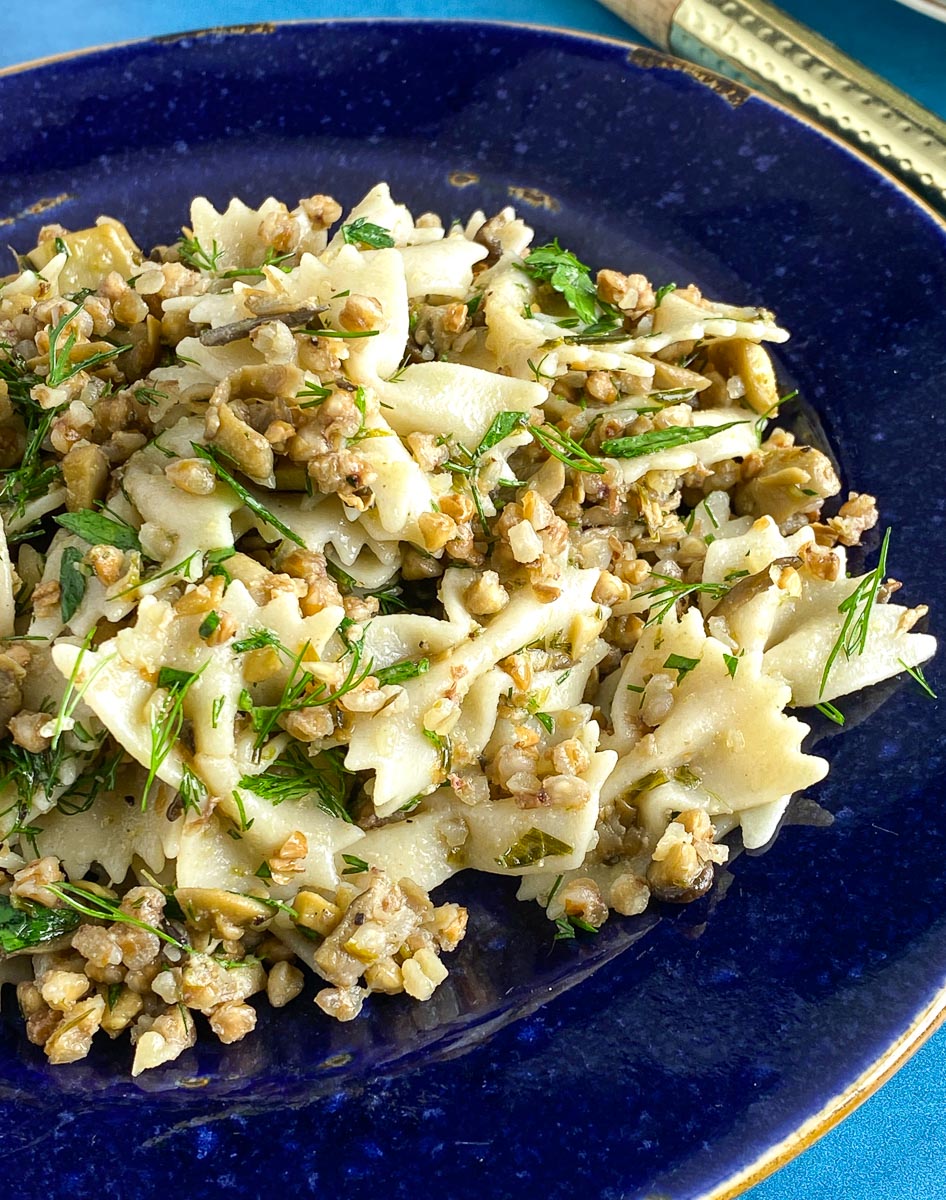
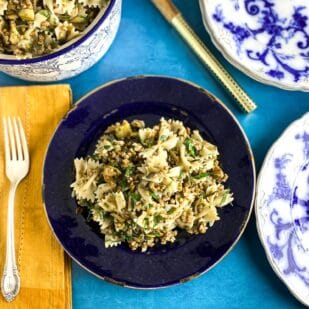
Low FODMAP Kasha Varnishkes
Our Low FODMAP Kasha Varnishkes are not quite like the classic as that recipe requires quite a lot of thinly sliced, caramelized onion. We have done our best and used the traditional buckwheat groats, schmaltz (chicken fat) and (low FODMAP gluten-free) bow tie pasta and combined these ingredients with loads of scallion greens, leek greens and some of the white leek bulb.
Low FODMAP Serving Size Info: Makes about 2 pounds (910 g) or about 12 cups; 12 servings; 1 cup (76 g) per serving
Ingredients:
- Kosher salt
- 8- ounces (225 g) low FODMAP gluten-free farfalle (bowtie) pasta, such as Jovial
- ½ cup (120 ml) plus 2 tablespoons schmaltz (chicken fat), divided
- 1 tablespoon extra-virgin olive oil
- ¾ cup (54 g) very finely chopped leek greens
- ½ cup (32 g) finely chopped scallions, green parts only
- ¼ cup (18 g) very finely chopped leek bulb
- 1 ½ pounds (680 g) trimmed and sliced oyster mushrooms
- Freshly ground black pepper
- 1 large egg, at room temperature
- 1 cup (170 g) coarse toasted buckwheat groats, such as Wolff’s brand
- 2 cups (480 ml) low FODMAP chicken stock, homemade or purchased equivalent
- ½ cup (16 g) chopped fresh dill, plus extra as needed
- ¼ cup (8 g) chopped fresh flat-leaf parsley, plus extra as needed
- 1 teaspoon FreeFod Onion Replacer
Preparation:
-
Fill a large pot with generously salted water and bring to a boil over high heat. Cook the noodles till al dente and drain, then add back to the pot.
-
Meanwhile, in a large wide saucepan or skillet over low-medium heat, melt and heat the ½ cup (120 ml) of schmaltz and olive oil. Add the leek greens, scallion greens and leek bulb and cook, stirring often, until golden, about 20 to 25 minutes; don’t rush this step. Add the mushrooms, season with salt and pepper and cook, stirring often, until the mushrooms give off most of their liquid and the leeks and scallions have darkened further, about 10 minutes more. The mushrooms will retain some bouncy texture. Taste, and season with additional salt and/or pepper, as needed. Transfer the mushroom mixture to the pot with the pasta. Wipe out the pan and set aside for later.
-
Beat the egg in a small mixing bowl, then stir in the dry, raw groats, making sure all the grains are evenly coated. Scrape the kasha into the reserved pan and set over medium heat. Spread the kasha out into an even layer and stir for a few minutes or until the egg has dried on the kasha grains, the kernels take on some color, begin to emit a toasted fragrance, and are mostly separate. Stir in the chicken stock, cover, bring to a boil, then adjust heat to low and cook until stock is absorbed, and groats are tender, about 10 minutes (give or take). Fluff the grains with a fork and re-cover the pot to steam for a few minutes.
-
Add the cooked buckwheat to the pasta along with the dill and parsley, reserved 2 tablespoons schmaltz and FreeFod Onion Replacer to the pasta pot. Fold until everything is combined and heat gently over low heat, if needed. Taste, adjust seasoning and serve. Leftover kasha varnishkes can be refrigerated in an airtight container for up to 4 days. We like to reheat in a pan with more schmaltz until some of the noodles are a bit crispy. A shower of fresh herbs is nice, too, right before serving.
Notes:
FODMAP Information
Our recipes are based on Monash University and FODMAP Friendly science.
• Eggs: Eggs are high in protein and do not contain carbohydrates, according to Monash University.
• Leeks: The green parts of leeks are low FODMAP as determined by Monash University lab testing and can be used to add onion flavor to your low FODMAP cooking. Monash also states that a combination of leek bulb and leek greens are low FODMAP in ½ cup (38 g) portions, but we do not know the ratio of bulb to greens.
• Pasta: You have to read labels, but there are many low FODMAP gluten-free brands of pasta available. Use what is called for in individual recipes. Our go-to is rice-based pasta. Monash University and FODMAP Friendly have both tested “gluten-free” pasta, but they do not specify what the pasta was made from. Monash says gluten-free pasta is low FODMAP at 145 g or 1 cup cooked; FODMAP Friendly lab testing suggested 2 cups or 146 g cooked is low FODMAP. Monash has also lab tested pasta made from rice, which they list under “rice stick” and it is low FODMAP at 220 g, which no Moderate or High FODMAP amounts given.
• Scallions: The green parts of scallions are low FODMAP as determined by Monash University lab testing and can be used to add onion flavor to your low FODMAP cooking.
Please always refer to the Monash University & FODMAP Friendly smartphone apps for the most up-to-date lab tested information. As always, your tolerance is what counts; please eat accordingly. The ultimate goal of the low FODMAP diet is to eat as broadly as possible, without triggering symptoms, for the healthiest microbiome.
Nutrition
All nutritional information is based on third-party calculations and should be considered estimates. Actual nutritional content will vary with brands used, measuring methods, portion sizes and more. For a more detailed explanation, please read our article Understanding The Nutrition Panel Within Our Recipes.
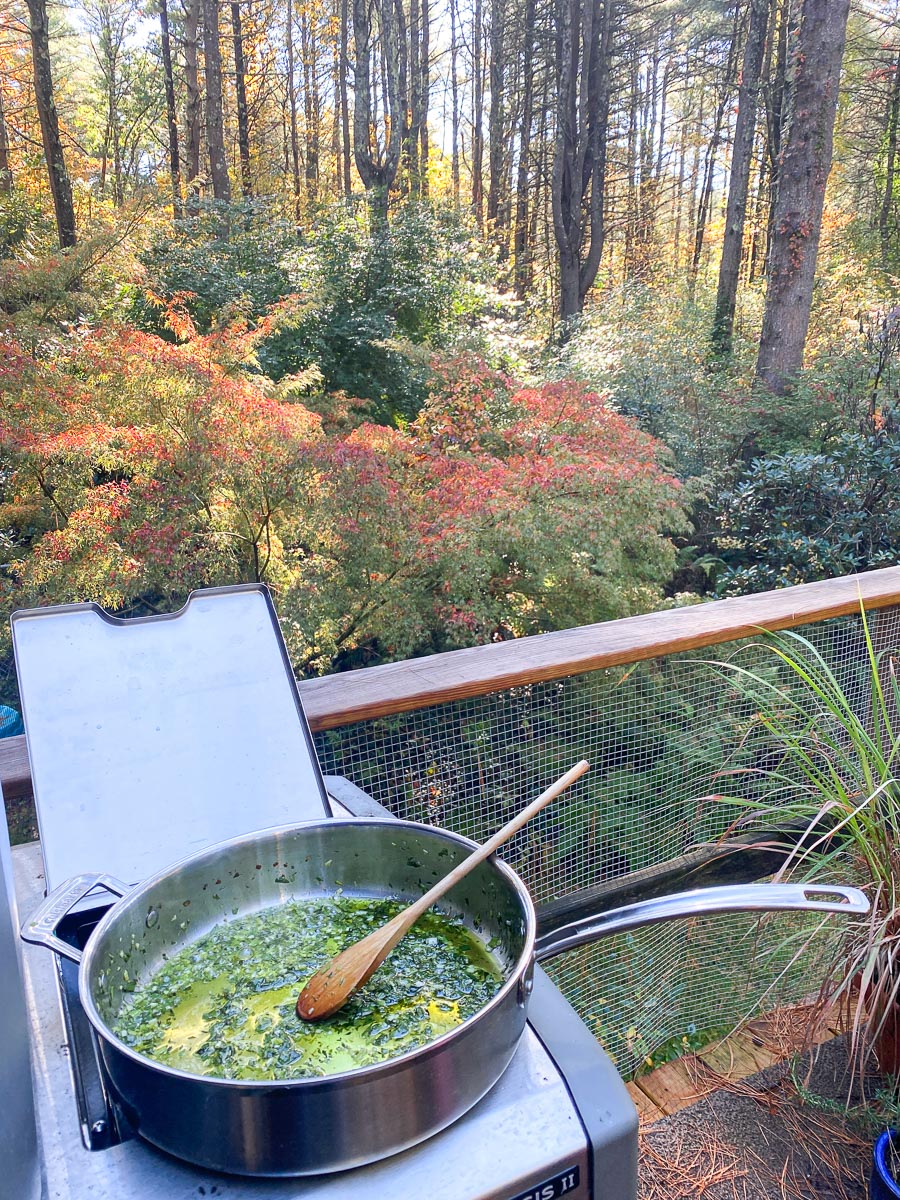

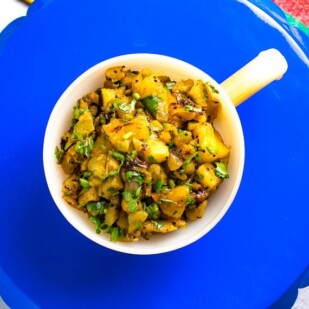






Kasha varnishka would not be appropriate for Passover, neither kasha or wheat pasta are Kosher for Passover. Sorry.
This is from Chabad.Org. Of course I understand that every family will have their own traditions. “
Buckwheat is not wheat and therefore not chametz, grain which has risen. However it included in the general class of kitniyot, foods that Ashkenazim (and some Sephardim) may not eat on Passover.
This was enacted because kitniyot dishes are similar to chametz. This prohibition also includes corn, beans and rice. This injunction was unanimously accepted by Ashkenazic Jews; many Sephardic Jews, however, continue to eat kitniyot on Passover, provided that they were carefuly checked to ensure that no grains were mixed in. If you are Sephardic, speak to your rabbi to determine your family and community tradition.”